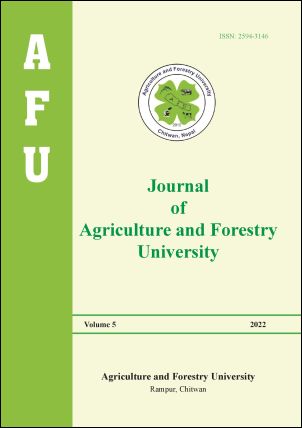Effect of foliar application of different nutrients on growth, yield, and quality of potato (Solanum tuberosum L.) in Sankhu, Kathmandu, Nepal
DOI:
https://doi.org/10.3126/jafu.v5i1.48443Keywords:
Deficiency, management, minerals, potatoAbstract
A study was conducted from January to June 2021 in the farmer’s field at Shankharapur-7, Sankhu, Kathmandu, Nepal to assess the effectiveness of the foliar application of different nutrients for potato production. The field experiment was laid out in Randomized Complete Block Design with six treatments, T1: zinc at 560 ppm, T2: magnesium at 0.4 %, T3: boron at 100 ppm, T4: calcium at 0.8 %, T5: copper at 1 %, and T6: control and were replicated four times. The chemicals were sprayed 30 and 40 days after planting until runoff. The highest tuber yield was obtained with the application of calcium at 0.8 % (38.57 Mtha-1) while the lowest marketable tuber yield was obtained with copper at 1 %. The highest calcium and zinc content in potato tuber was observed with the application of calcium at 0.8 % and zinc at 560 ppm respectively. Likewise, the application of zinc increased the protein percentage in tuber by 23 % compared to the control. Thus, it can be concluded that the foliar application of calcium at 0.8 % is the most economical resulting in the highest plant growth, yield, and producing the best quality potatoes under the climatic condition of Sankhu, Nepal.
Downloads
Downloads
Published
How to Cite
Issue
Section
License
Copyright (c) 2022 Agriculture and Forestry University (AFU), Rampur, Chitwan, Nepal

This work is licensed under a Creative Commons Attribution-NonCommercial 4.0 International License.
This license allows reusers to distribute, remix, adapt, and build upon the material in any medium or format for noncommercial purposes only, and only so long as attribution is given to the creator.




